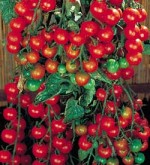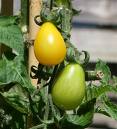
As the weather becomes warm and the soil temperature rises, I begin to consider what tomatoes I am going to grow during the summer. Tomatoes are my favorite vegetable crop and if my crop is not adequate I consider my summer a failure. I eat tomatoes until my mouth is filled with canker sores, I treat the canker sores, and keep on eating the tomatoes. That’s how much I love tomatoes! And I expect to eat them fresh from the garden until frost.
Although I sometimes start tomatoes indoors 6-8 weeks before the last frost date I always buy some seedlings to get a head start on the tomato season. I usually go to the local farmers’ market to get the seedlings because there are more varieties available and usually at better prices than elsewhere. Here is what to consider when choosing tomato varieties:

1. Determinate vs indeterminate types: The terms refer to the grow habit of the variety and all tomatoes belong to one group or the other. The determinant types grow to a certain height and no taller. This growth habit also means that the plant will produce its tomatoes in a brief span of time (3-4 weeks) and then die. The indeterminate tomatoes keep growing until frost, producing tomatoes until then so they may get very large and will need supports. Determinate plants are easier to control and tend to mature earlier than indeterminate types.
2. Use of the tomato crop: Are you going to eat them fresh off the vine? Can them? Cook with them? Large round varieties and small cherry types have abundant juice and seeds and are best eaten fresh and uncooked. The plum shaped ones are better for canning and sauce making.
3. Color: yellow or red. The yellow are sweeter because they have a higher sugar content but they have the same acid content as red. Some people, like my husband, just don’t like the idea of yellow tomatoes. What can I say? Yellows come in the same shape as reds, can be determinate or indeterminate and can be eaten fresh or canned same as red. I won’t even get into some of two-toned tomatoes.
4. Size of Fruit: Tomatoes (botanically a fruit, that is a ripened ovary) may be huge, large, medium, or small (1”). Small ones are easy to put into salads while medium and large ones are good for slicing. Huge ones are good for bragging about.
5. Size of Plant: Tomato plants, reds and yellows, come in a variety of sizes. You can get huge, medium, or dwarfs plants, although I have had difficulty finding the true dwarfs.

6. Shape of the fruit. Tomatoes can be roundish, oblong, pear shaped, grape shaped, and variations of these basic shapes. Whatever shapes give you pleasure are the right ones.
7. Disease: Tomatoes are susceptible to a variety of diseases but some varieties are more resistant to the common ones, Fusarium, Verticillium, Alternaria, Tobacco mosaic virus, and nematodes. These are all found in the soil and once the plant is infected it begins to die. Depending on the stage of development you might get some tomatoes before it dies but you might not. You can cut down the chance of these diseases by planting tomatoes in a different part of your garden on a three year rotation, not smoking (Tobacco Mosaic can be spread to you tomatoes by hands that have held a cigarette), and/or choosing resistant varieties. Few varieties are resistant to Tobacco Mosaic Virus but several are resistant to the other diseases. Just look on the package or label of the plants you intend to grow.
Here are my recommendations based on the above points:
Abbreviations:
A=Alternaria fungus
F=Fusarium fungus
N=Nematodes
T=Tobacco Mosaic Virus
V=Verticillium fungus
Early Red
‘Quick Pick’ ; 60 days to harvest; resistant to VFNTA, heavy yield; indeterminate.
Main Season Red
‘Celebrity’ 70 days to harvest; large fruit, productive; semi-determinate; resistant to VFNT
‘Better Boy’ 72 days; indeterminate; resistant to VFN
Roma: standard red plum good for canning and making paste; tolerant to early blight; determinate; resistant to VF
Red Late Maturing and Extra Large
Beefmaster: large Beefsteak type; indeterminate; resistant to VFN
Red Small Fruit on Large Plant
‘Sweet Million’ 1 inch fruit; sweet, crack resistant; large clusters; indeterminate; resistant to FNT
Red Small Fruit on Dwarf Plant
‘Tiny Tim’; 1 inch fruit; very dwarf, red cherry fruit; determinate
Yellow
‘Mountain Gold’: determinate; resistant to VF
Your favorite may not be on this list and that probably means I have not found it readily available as seedlings. Your local vendors generally carry the varieties/cultivars that do best in your area. They also carry plants that are popular for other reasons. Here in North Carolina ‘German Johnson’ tomatoes are enormously popular and so the seedlings are easy to find. They are an heirloom variety that is not disease resistant but they are grown in great quantity, and yes, I am trying them this year for the first time.
If you would like tips for growing tomatoes see my: Ten tips for successful tomatoes

Very informative. This is my first year growing tomatoes, and I know I like the really meaty ones for when I make pico de gallo. I’m trying out the beefsteak and romas (grown from seeds), but I’m growing them in pots because I live in an apartment, any suggestions?
Thanks for all the in-depth information about tomatoes. Like you, I grow tomatoes every year, but never knew much about them. Last year I tried a variety called “patio tomato” which I liked. It stayed small, and produced little, tasty fruits for a long time. I only have space to grow in pots, so I like the ones that stay small. I also like the “Sweet 100” cherry tomato. It’s real easy to start from seed. I just bury the bird-pecked ones, and next year I have a new crop!
Enjoy your tomatoes this year. I hope you don’t get too many canker sores!
I am glad you mentioned your patio tomato. I have never grown one in a container but maybe I should try.
The biggest problem with containers is watering. The pots tend to dry out very quickly so my top suggestion is to check them daily and make sure they don’t dry out. The use of plastic pots helps to keep the soil moist. Food luck and good eating!
I am an avid organic gardener and this is a very helpful post with lots of great information. I have learned that full, all day sun and not overwatering is a key for me. Also, ladybugs, which can be purchased online or at some garden centers if need be, are the best pest control system available. Two of the extra benefits of ladybugs is you won’t need pesticides sprayed all over the fruit you and your family will be eating, and when the ladybugs have eaten all the pests, they simply move on; often to feast on the pests you may have on other plants, like roses.
Good point about the ladybugs especially since I grow roses too. Right now they are feasting on the aphids.
I have grown tomato plants for years. I wanted to try container planting this year. Thanks so much for the tips. It was perfect timing 😉
Thanks for the comment. I have been inspired by readers and just bought 6 patio tomato plants. I am going to plant them in my culinary herb garden outside my kitchen door in pots usually used for flowers.
[…] Hopefully, you have picked disease resistant tomatoes that meet your other requirements and have set the stage for […]
Gardening is so relaxing and a wonderful way to spend time outdoors. It is one of my favorite hobbies that I love to share with others online! Thanks for taking the time to write this post, I always learn so much about gardening from many different sources online!
🙂
[…] is an old favorite and was an All America Selection Winner in 1984. Some authorities consider it determinate others indeterminate, so perhaps it is semi-determinate. Whatever you call it, it grows very tall and easily reaches the […]
[…] tossing into a salad and ‘Lizzona’, an All American Selection winner, is one of the best. It is semi-determinant and compact yet has an abundant yield of 1” fruits that are lauded for their good taste and […]